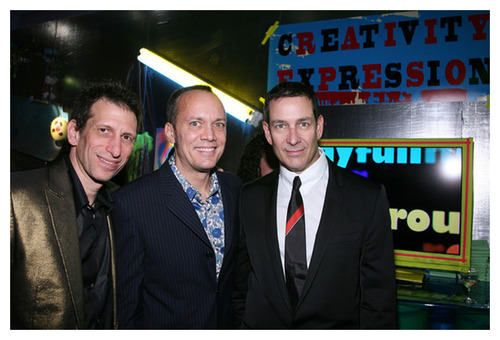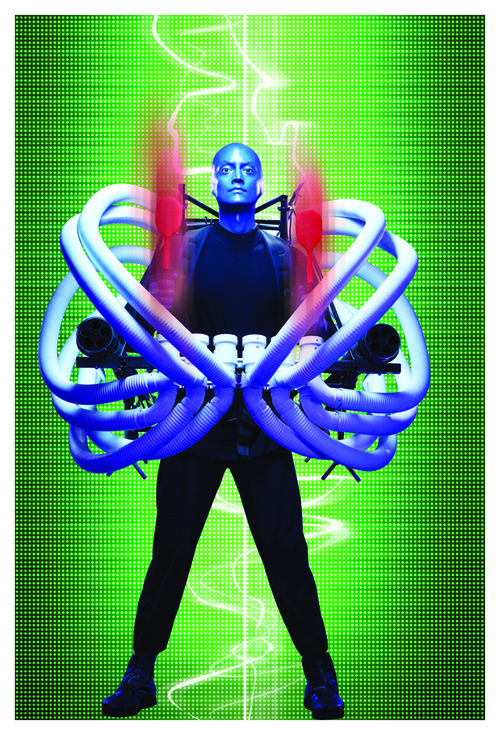Coloring the world blue: The history of Blue Man Group
 Matt Goldman, Chris Wink and Phil Stanton are entrepreneurs who created and oversee a global enterprise that has brought joy to more than 17 million people. They are also innovators, educators, artists, and contemporary comedians, known collectively as the founders and originators of Blue Man Group. That these three bald and blue characters would become a cultural phenomenon is an idea that was all but unimaginable when these inscrutable beings first emerged, walking the streets of New York.
Matt Goldman, Chris Wink and Phil Stanton are entrepreneurs who created and oversee a global enterprise that has brought joy to more than 17 million people. They are also innovators, educators, artists, and contemporary comedians, known collectively as the founders and originators of Blue Man Group. That these three bald and blue characters would become a cultural phenomenon is an idea that was all but unimaginable when these inscrutable beings first emerged, walking the streets of New York.
“We weren’t really goal-oriented,” says Stanton. “When we started walking around the city, we did it because we wanted to see how people reacted. And being bald and blue was our social life. We didn’t want to go to bars and be part of a singles scene, a drinking scene. We wanted our social life to be somehow creative, and this was a lot of fun. We knew we would eventually do some kind of performance, but we never envisioned a commercial theater run.”
The show is an absurd and wondrous blend of music, painting, science and technology, as the Blue Men silently engage in a variety of set pieces that run the gamut from primitive and childlike to witty and sophisticated.
 “It’s all about creativity and innovation,” says Puck Quinn, creative director of character development and appearances. “If someone asks, ‘What does Blue Man Group do?,’ my answer is simple: ‘We innovate.’”
“It’s all about creativity and innovation,” says Puck Quinn, creative director of character development and appearances. “If someone asks, ‘What does Blue Man Group do?,’ my answer is simple: ‘We innovate.’”
Everything begins with the Blue Man, and although he’s been around for more than two decades, his founders still can’t entirely explain where he came from. Like the character himself, his origin is enigmatic.
“There really isn’t an explanation,” says Goldman. “Chris dug up a picture that he drew when he was five years old, and it had three blue men in it. And I had a thing in my wallet for years with a blue tribe in South America. I don’t know why it was there; I never put pictures in my wallet. We think the Blue Man has always been here. The best answer is that we found each other.”
The impulse for going bald and blue emerged, in part, when the three longtime friends observed a clash of cultures on a New York sidewalk that no one else noticed.
“We saw three punk rockers – giant Mohawks, safety pins in the cheekbone area, leather and chains – walk between three other gentlemen who were dressed in Armani suits and carrying alligator briefcases,” says Goldman. “These six guys didn’t even blink, and the people around them didn’t even blink. And we turned to each other and said, ‘If that scene didn’t even get one iota of consciousness put to it, what human imagery possibly could?”
Eventually, an image began to emerge.
“We thought, ‘What would surprise people?” says Stanton. “‘What’s going to catch someone’s eye and make them think?’ We thought that if we created a bald and blue character, that image would have the ability to surprise and spark some thought for a long time.”
 Goldman adds, “The first time we got bald and blue, we knew instantly it was something very special. And it was so freeing, because it wasn’t us. Our own egos were gone.”
Goldman adds, “The first time we got bald and blue, we knew instantly it was something very special. And it was so freeing, because it wasn’t us. Our own egos were gone.”
The traits of the Blue Man developed gradually.
“There was something about him that seemed timeless, and something that seemed a little bit futuristic,” says Stanton. “He seemed to have the ability to be beautiful and comic at the same time. I’m not even sure we thought about that at first. It was really intuitive. We were trying to create a character that somehow represented humanity, but was able to be outside of humanity and look at it at the same time. We wanted to make a statement about community, about the power of a group, as opposed to the American individualist mentality. We thought the character would express community through something tribal, and drumming seemed the way to go. Chris had trained as a drummer, and I was from a really musical background. We wanted to draw from our own interests and backgrounds, and bring them into some kind of performance. We wanted to express something about the process, or the impulse to create.”
 They continued to develop material for three years, performing in downtown clubs and event spaces. Two decades later, Goldman, Stanton and Wink are still tinkering with, refining, and updating the show. Each additional production, including the tour, provides an opportunity for new material.
They continued to develop material for three years, performing in downtown clubs and event spaces. Two decades later, Goldman, Stanton and Wink are still tinkering with, refining, and updating the show. Each additional production, including the tour, provides an opportunity for new material.
“Sometimes we just see something that we think is really cool, and we’ll try and see how we can make it theatrical,” says Stanton.
Blue Man Productions, the parent company that oversees all projects, employs several hundred people around the world. Goldman, Stanton, Wink and their staff pay the same attention to the details of their business as they do to the details of their art.
“From the beginning, we valued what went on offstage as much as what went on onstage,” says Stanton. “It’s important to us how people are treated. The creativity that goes into what happens offstage is viewed as part of what ends up onstage. We never separate the two. We always wanted to own our own show, and live with the decisions that we made, rather than hand all of that off to somebody else. We want to be responsible for what happens, and we wanted to make sure it was a life-long journey.”
Blue Man Group plays Denver’s Buell Theatre April 12-21, 2013. Tickets: 303.893.4100; Toll free 800.641.1222 or TTY 303.893.9582.
5 notes
akai-tenshi23 reblogged this from denvercenterblog
anyminuteanydaynow reblogged this from denvercenterblog
 ghostkingminos-blog liked this
ghostkingminos-blog liked this denvercenterblog posted this
